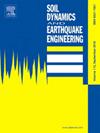Seismic fragility assessment of non-invasive geotechnical seismic isolation for existing bridges
IF 4.2
2区 工程技术
Q1 ENGINEERING, GEOLOGICAL
引用次数: 0
Abstract
Geotechnical seismic isolation (GSI) is a new concept that has been proposed recently. The injection of polyurethane into the soil layer (non-intrusive GSI) reduces seismic fragility without altering the original structure, which may provide an effective seismic isolation solution for existing bridge structures. The purpose of this study was to investigate the seismic isolation effect and isolation mechanism of non-invasive GSI applied to existing bridges. First, a noninvasive GSI site modeling method is described based on the results of existing soil-polyurethane resonance column tests and the OpenSees computational platform. Subsequently, a refined dynamic analysis model of site-existing bridge interactions was established by combining the rusting theory. The seismic isolation effect of the non-invasive GSI and its effect on the seismic response of the bridge were explored using a nonlinear dynamic time-course analysis. The results showed that non-invasive GSI soils can change the characteristic period of ground motion, thus reducing the site effect. The seismic isolation effect was positively correlated with the percentage of injected polyurethane. Altering the characteristic period of the site and avoiding as many of the preeminent periods of ground motion as possible is the result of noninvasive GSI. The non-invasive GSI soil layer reduces the structural response and provides seismic isolation throughout the life cycle of corroded piers, and its fragility is significantly reduced. Especially, the “old” piers have significant seismic isolation effect, effectively limiting serious damage or even collapse under earthquakes. The results of this study provide a reference for noninvasive GSI design of existing bridge structures.
求助全文
约1分钟内获得全文
求助全文
来源期刊

Soil Dynamics and Earthquake Engineering
工程技术-地球科学综合
CiteScore
7.50
自引率
15.00%
发文量
446
审稿时长
8 months
期刊介绍:
The journal aims to encourage and enhance the role of mechanics and other disciplines as they relate to earthquake engineering by providing opportunities for the publication of the work of applied mathematicians, engineers and other applied scientists involved in solving problems closely related to the field of earthquake engineering and geotechnical earthquake engineering.
Emphasis is placed on new concepts and techniques, but case histories will also be published if they enhance the presentation and understanding of new technical concepts.
 求助内容:
求助内容: 应助结果提醒方式:
应助结果提醒方式:


